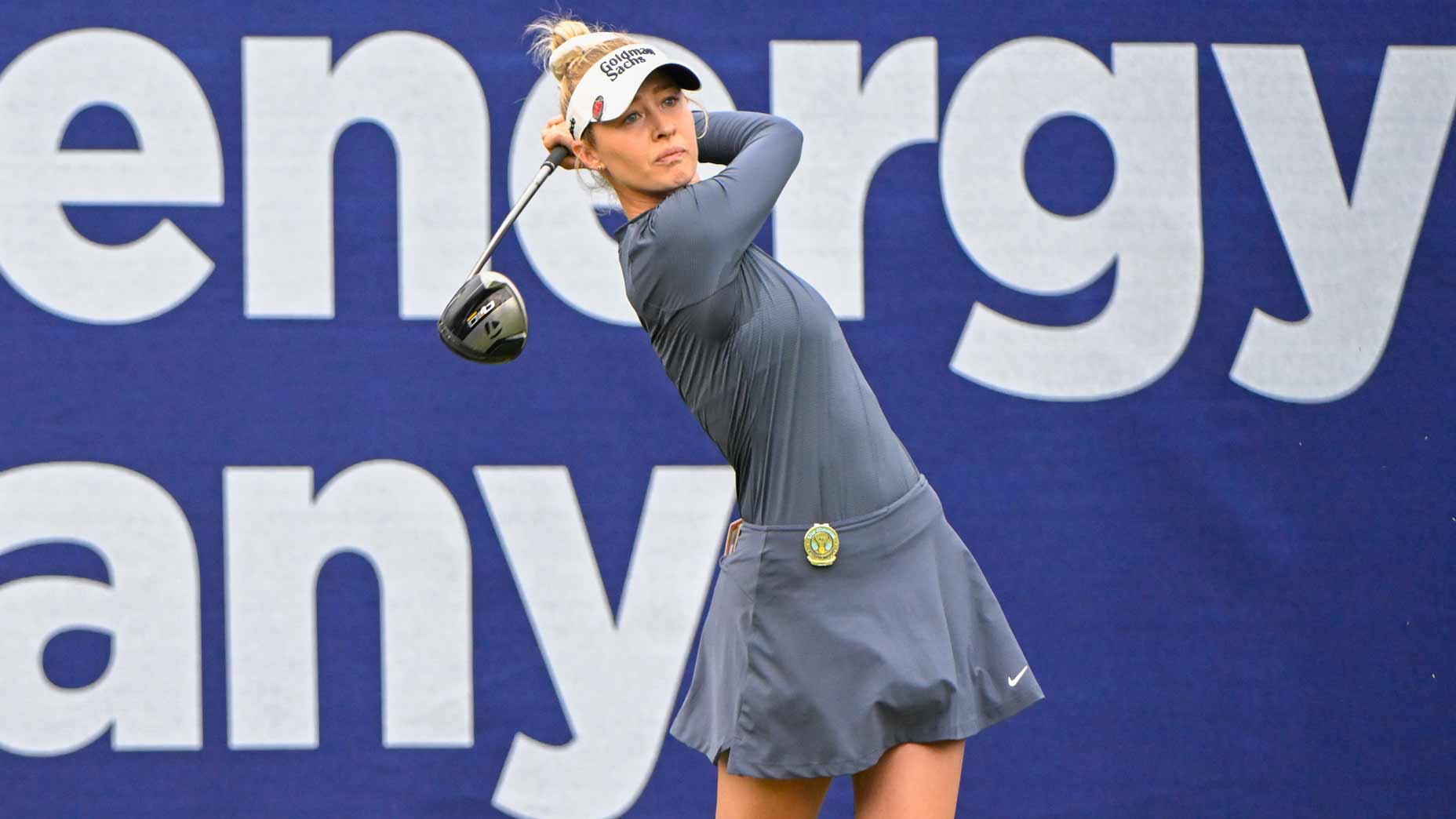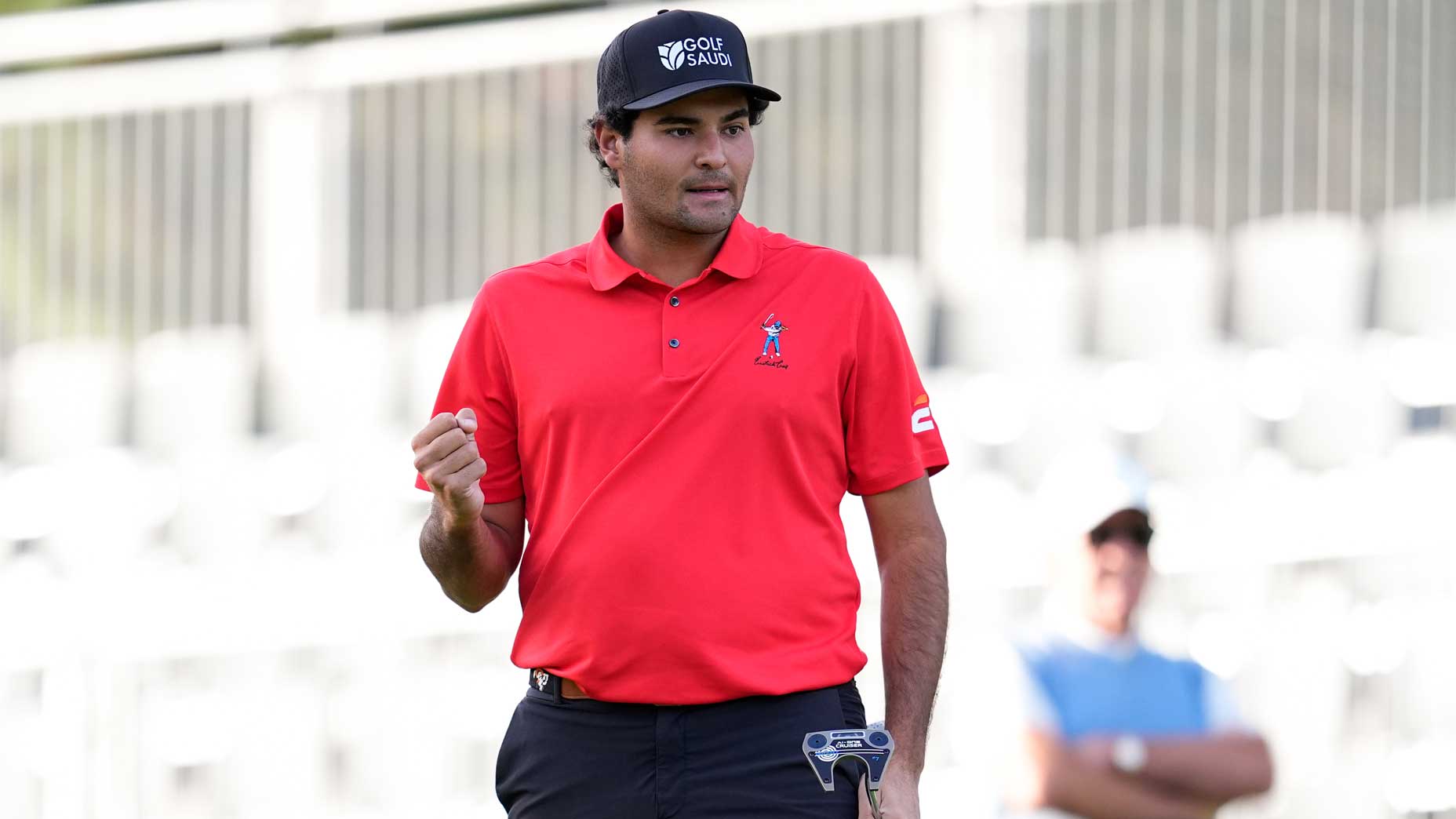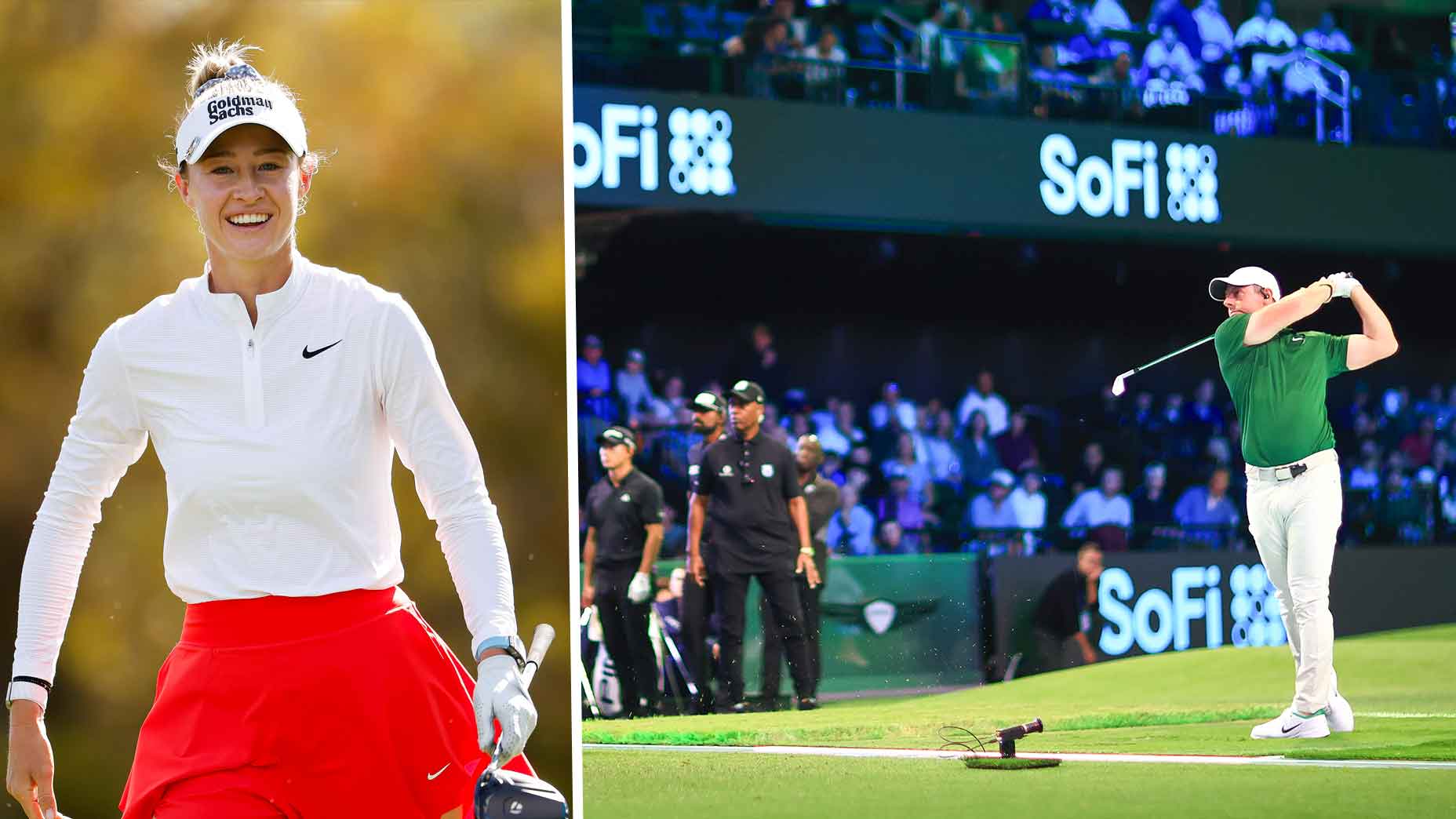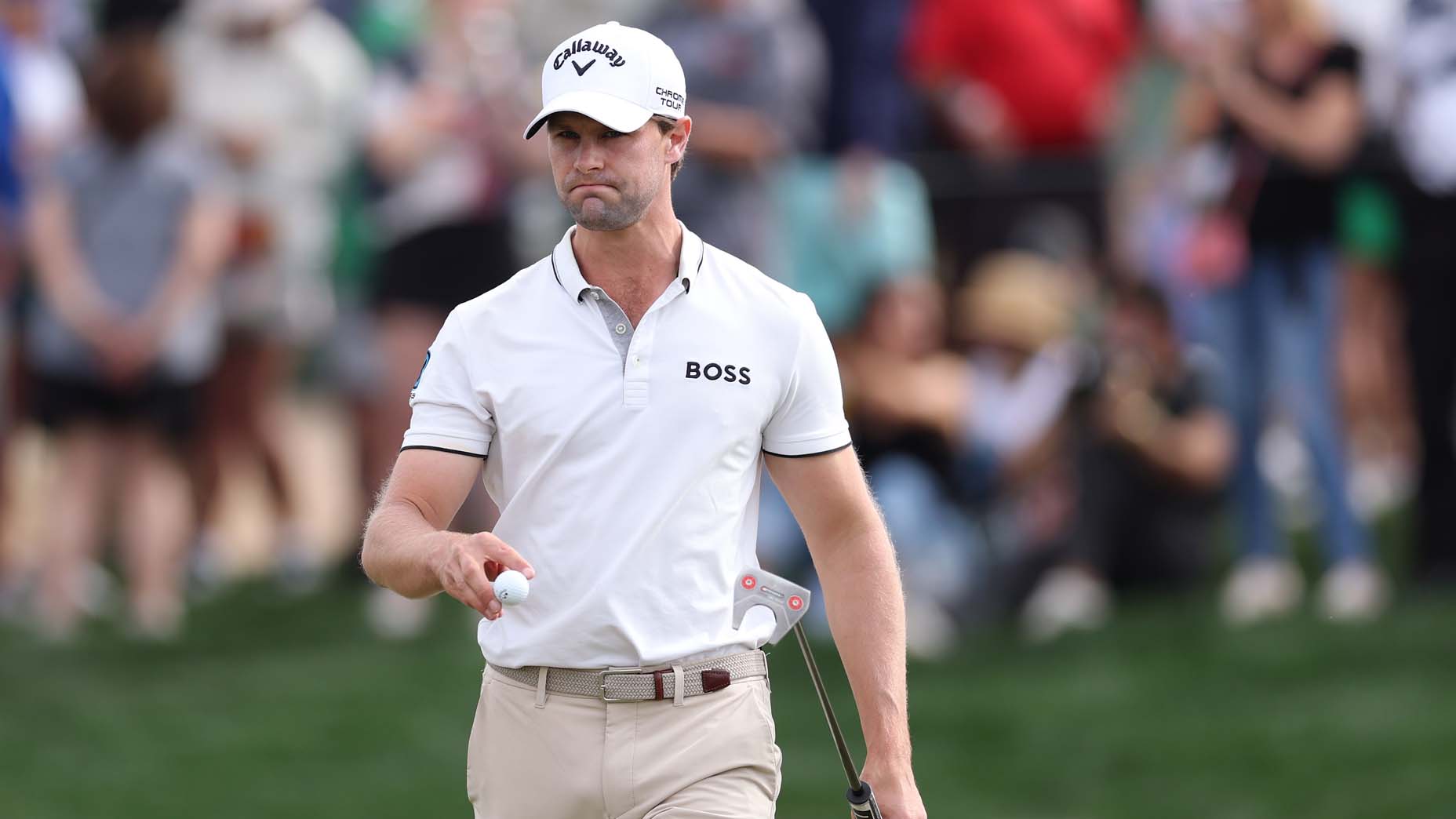This is the third installment in our seven-part The Modern Pro series, in which GOLF.com is breaking down what it means to be an elite professional golfer in 2018. In previous editions, we broke down players’ swings and bodies. This week we examine their brands.
———————————–
On the west end of the lush practice range at the Albany resort in the Bahamas, Rickie Fowler stripes ball after ball as he prepares for his Saturday tee time at the 2017 Hero World Challenge.
Fowler is one of the game’s biggest draws, but not the biggest. Not this week, with Tiger Woods back in the field. Yet in a small event on a small island with even smaller galleries, children and adults alike line the ropes to catch a glimpse of the man who has single-handedly made the color orange cool.
Fast forward 30 hours and a victorious Fowler, decked out in flashy Puma gear, is standing next to Woods, the tournament host, as he’s presented the trophy after shooting a course-record 61 in the final round. Fowler will do a myriad of interviews and grin for photos with his girlfriend, Olympian pole-vaulter Allison Stokke. In the coming hours he’ll commemorate the victory on his Snapchat and Instagram accounts — a million-plus followers strong on each — and dutifully tag Cobra’s new F8 driver, which he used in competition for the first time in the Bahamas.
Fowler is a marketer’s dream: a handsome, stylish, media-savvy, well-spoken pro golfer with a buzzy, athletic main squeeze. As Fowler basks in victory, there are several other winners, too: his sponsors. Mercedes-Benz, Puma, Cobra, Red Bull, Wheels Up. Rickie has done it again.
#https://instagram.com/p/BcSMm-znIPJ/
Still, the number of times Rickie has “done it” is not exactly commensurate with his immense popularity. Fowler, who turned 29 last month and is in his ninth season as a pro, has won twice on the European tour and four times on the PGA Tour (the Hero World Challenge is not an official PGA Tour event). Among the players who have won more than him on Tour: Ryan Moore (five titles), Jason Dufner (five), Ben Crane (five), Hunter Mahan (six) and Bill Haas (six). Cumulatively those players’ social followings fall far short of Fowler’s, which shows you how valuable a bright, ambitious athlete with an ever-charged phone can be.
“Rickie Fowler is an interesting case,” says Kurt Badenhausen, a senior editor at Forbes who covers sports business and contributes to Forbes’ lists of the most-marketable and highest-paid athletes. “He’s different from everybody else, certainly from a style standpoint, and you can credit Puma. He became a very marketable golfer before he had a lot of success on the course. But he was a good-looking guy that Puma dressed in a very noticeable way, and that I think drew lots of attention. I think that helped him attract a fan base and led to more deals.”
On the women’s side of the game, 20-year-old Lydia Ko, 22-year-old Lexi Thompson and 28-year old Michelle Wie are among those setting the pace. Bobby Kreusler has known Thompson since she was 9 years old and his company, Blue Giraffe Sports, has managed her since she turned pro at 15. He still recalls Lexi, at 12 years old, playing in her first U.S. Women’s Open. Standing in front of a huge gallery on the 1st tee at Pine Needles, she stood over her ball and “absolutely just piped it.” Kreusler says Thompson was born with the “it” factor.
“I saw it early on,” he said. “She’s always had it.”
Across Facebook, Twitter and Instagram, Thompson is closing in on one million followers. Her Twitter bio pays homage to the brands that pay her: “21 year-old @RedBull @CobraGolf @PUMAgolf @Zurich @Rolex @LPGA @Lexus @Smuckers golfer, gym rat, family oriented girl out living my dream.”
#Ad Another golf season, another year playing with my favorite #PB&J ! #Uncrustables pic.twitter.com/mjNWVBqOvv
— Lexi Thompson (@Lexi) May 22, 2017
What Fowler, Thompson and countless other golfers have accomplished when it comes to the creation and promotion of their “brands” is thanks largely to Arnold Palmer, a dashing, charismatic talent who just about jumped off TV screens and into viewers’ living rooms. Palmer and his advisors monetized that dynamic like no golfer before him.
“What Palmer did was absolutely revolutionary,” Badenhausen said. “The athlete never had the power. They were always under the thumb. In team sports, it was always under the thumb of the owner, and from an endorsement standpoint these guys never really took control of the narrative and how they were portrayed. IMG and Palmer together did that with him, and it created a financial empire.”
In the post-Palmer era, the art of branding and marketing continues to evolve. Social media is an ever-growing avenue for athletes to market themselves. Though Badenhausen says he doesn’t think it’s necessary for athletes to have a strong social presence to command top dollar, he believes authenticity is important. Kreusler, whose agency represents about 40 pro golfers, says that not all athletes are comfortable letting the universe into their worlds. For those who are, their message must be genuine — or people will see through it.
“I think that term [brand] is overused because not every player has an opportunity to have a genuine brand,” Kreusler said. “Every player has an opportunity to create their own unique personality and identity, but a brand is a higher level of achievement and success.”
For those who do reach brand-name level, it’s highly lucrative. In Forbes’ recent list of the world’s 100 highest-paid athletes, five are golfers, and four of them rank in the top 25 — the second most of any sport, trailing only basketball, which has eight players in the top 25. Rory McIlroy (6th, $50 million) leads the list of golfers and is followed by Phil Mickelson (12th, $43.5 million), Tiger Woods (17th, $37.11 million), Jordan Spieth (21st, $34.5 million), and Dustin Johnson (48th, $27.6 million).
According to Forbes, which computes athletes’ salaries/earnings and endorsement estimates on a June-to-June rolling calendar, among golfers only Johnson made more in winnings ($16.6 million) than endorsements ($11 million). Through endorsements alone, McIlroy made $34 million, Mickelson $40 million, Woods $37 million, Spieth $29 million and Johnson $11 million.
“Golfers have a tremendous opportunity, because they are individual contractors,” Badenhausen said. “It’s also an extremely global sport. So these guys have opportunities to cut deals where marketing will be used around the world. That’s not something that exists in baseball or the NFL, so Nike can use a guy like Rory McIlroy throughout the world, which allows Rory to command a much bigger sum than he would if he was playing in a sport that’s [popular only in] one country. And the demographics are great, because the clientele that watches golf has very high disposable income that spends money on equipment and apparel and cars and watches and does a lot of financial services. So that makes these guys terrific walking billboards when they’re out on the course on Sundays.” 
That formula can add up to multiple lifetimes’ worth of security for players and their families. Last April, Nike announced an extension with McIlroy reportedly worth $100 million over 10 years. The following month McIlroy and TaylorMade announced an equipment deal of similar magnitude, yet another golden feather in his cap.
Clearly, business is good for the top dogs, but that’s not the case for everyone.
“The guys at the top, at the very top, are still commanding top dollar, but the guys right behind them aren’t seeing the same paydays that they used to off the course,” Badenhausen said. “I think it’s largely the nature of the business. For so long Tiger’s meteoric rise lifted all boats, but those days are over. This young group — Spieth and Johnson and McIlroy — they have a lot of opportunities. But there’s just not as much money in the sport right now. If you have fewer people bidding for your services, that’s gonna lead to a lower paycheck.”
Spieth, who at 24 is the youngest golfer on the Forbes list, teamed with Under Armour in January 2013 before signing a new 10-year contract in 2015 — just months before he won the Masters.
“From the start, even before he became a professional, we obviously saw the talent, but we also saw a kid with great character and a solid background,” said Ryan Kuehl, Under Armour’s VP of sports marketing and sponsorships. “His overall persona and makeup is what really drew us in — and has clearly drawn the sports world in as well. We knew that this was the kind of guy we wanted on our team.”
Spieth followed up his historic Masters victory — at 22, he was the second-youngest ever to win (behind only Woods) — by hoisting the U.S. Open trophy two months later and, soon after that, ascending to No. 1 in the World Ranking. Later in 2015 Under Armour filed three trademarks for a Spieth logo, which is now prominently displayed on the back of his hat. According to ESPN’s Darren Rovell, Spieth’s contract with Under Armour stipulates that he cannot wear any other logos on his body other than the company’s logo and his own (he has other sponsor logos on his bag). He’s an Under Armour man from head to spikes. In fact, just last week Spieth debuted his new signature UA shoe, the Spieth 2.
The deal seemingly has been a win-win for both sides. Since first signing with the company, Spieth has three major titles, 11 Tour wins, and marketers everywhere legitimately wondering if we have The Next Great Golfer on our hands.
“He’s going to win a lot of golf tournaments, and that’s going to end up costing us a lot of money at some level,” Under Armour CEO Kevin Plank said after Spieth’s 2015 U.S Open victory. “But I’d say it’s probably some of the best money we ever spent.”






